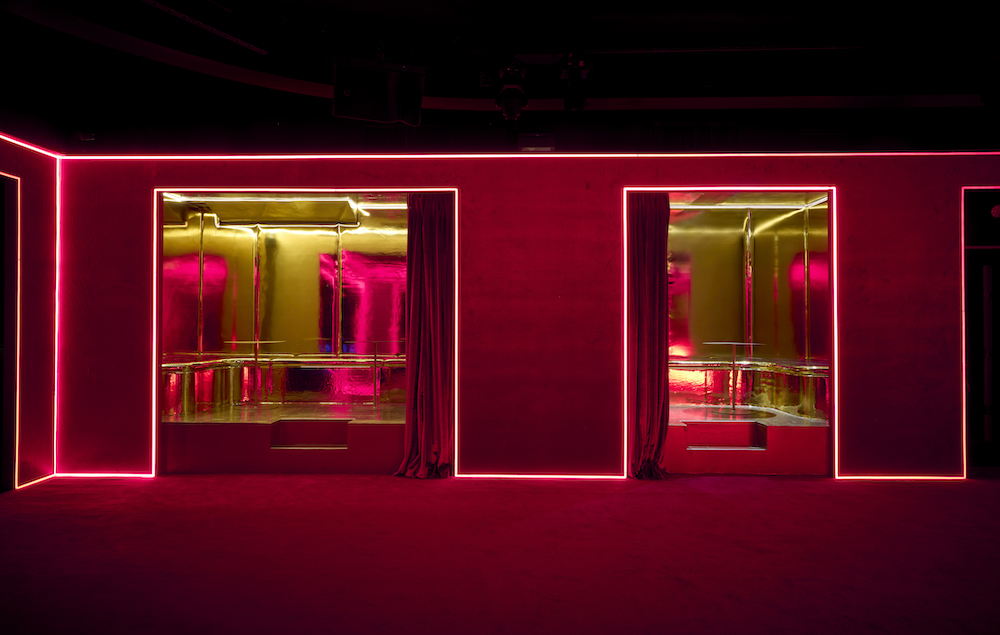At the entryway to Susan Chen’s “Plan B” at Rachel Uffner in New York (open through April 20) sits a small Purell bottle, tucked into a corner beside the pile of press releases and checklists. “Now more than ever,” the Purell bottle is how we are welcomed. It is a balm to ease your mind, a passive reminder to cleanse, and a demonstration that this institution is thinking about you. If you reflexively move your hand towards its pump, here, you would be disappointed. The Purell bottle in “Plan B” is ceramic. If the Purell bottle acts as a sentinel, Chen’s version asks us, what is our first line of defense? What happens when that falls through?
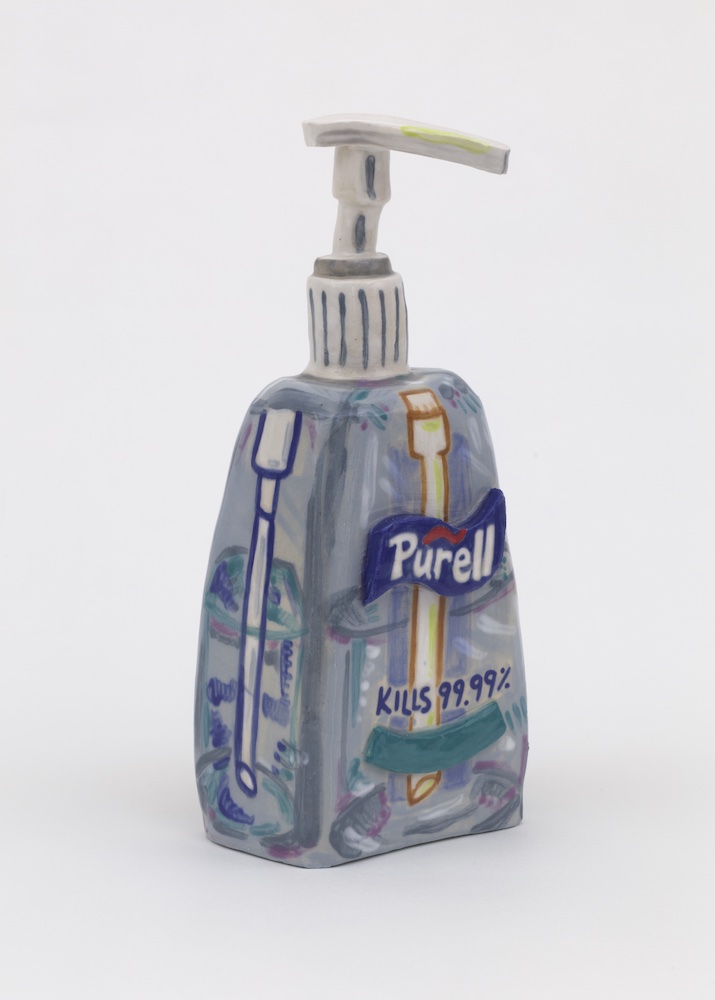
Susan Chen, “Purell Bottle (large),” 2023, ceramic, 9 x 4 x 2 1/2 inches, courtesy of the artist and Rachel Uffner Gallery.
Susan Chen asks, what happens when our first line of defense falls through?
In her solo show at Rachel Uffner, Chen thinks about what happens when the most straightforward solution is not available to us. More specifically, her multimedia series addresses the overturning of Roe v. Wade through clever ceramics and portraits of friends and individuals that Chen met through Planned Parenthood events. Based on long sittings with each subject, the portraits grapple with more than a political reality. Her paintings cultivate community and collaboration around protecting women’s agency.
When I spoke with Chen, she explained “Plan B” as an emergence from both her own experiences and a long-observed reality. “With abortion rights being taken away, it felt totally bonkers to me, as someone who grew up on the other side of the world for a bit,” said Chen, who grew up in Hong Kong. “I remember growing up with the one child policy really affecting everyone around me. It’s how the government controls women and how many kids they’re allowed to have. You heard all these stories of forced abortions.” Chen points to the way governments often restrict women’s bodies in a way that can be culturally specific, yet always constructed.
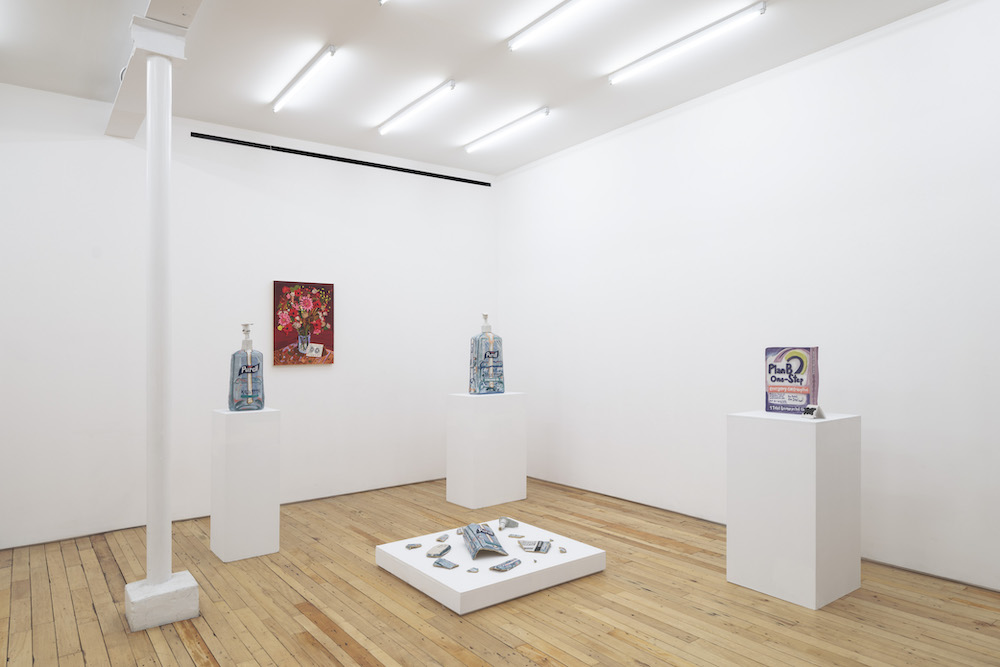
Installation view of Susan Chen’s “Plan B” at Rachel Uffner Gallery.
Susan Chen Responds to the Overturning of Roe v. Wade
After the Supreme Court decision came out in 2022, she was more viscerally affected than she expected to be. “I didn’t even realize that it would trigger me in a way,” she explained. “I was thinking about my own experiences of having taken Plan B when I was younger and being in a place of fear, but not being able to tell anyone about it. I’ve taken it twice, and both times, I didn’t tell anyone.” It is one of many examples wherein a societal shame moves inside your body, nesting there permanently–stuck there–even when you are most afraid.
In the first gallery, Chen presents a graveyard of ceramic Purell bottles alongside Plan B and Tampax boxes. The Purell bottles range in scale: from what you would find in an Uber driver’s cupholder to something almost monumental and confrontational. They are layered with glaze yet allude to transparency; Chen has carefully painted the pump’s stem behind the label. One Purell bottle has been shattered and splayed out, as if it somehow imploded.
Nearby, an oversized Plan B box rests beside a small sign declaring “VOTE,” and a Costco-sized ceramic Tampax box offers up free, very real tampons. They are there for the taking, a subversion of the “tampon tax” that taxes menstrual products as luxury goods, when they are, in reality, healthcare necessities. Even if the largest ceramics feel wonderfully absurd, the real sanitary products remind us how these matters live within our bodies, how fundamental they are to our lives.
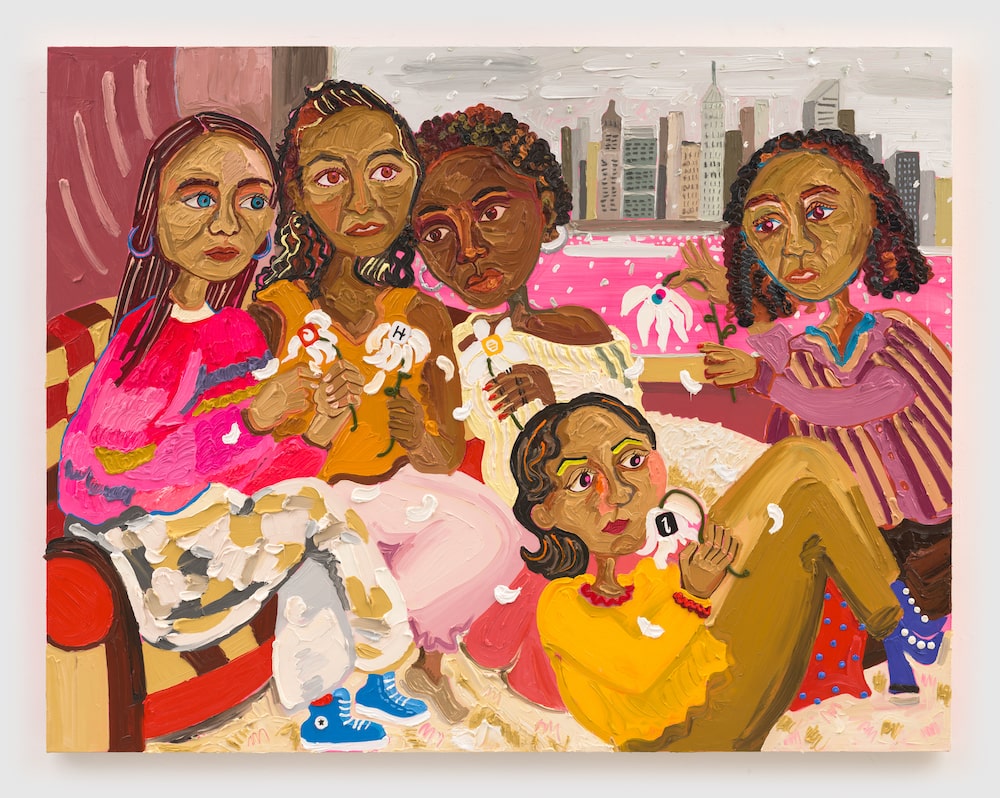
Susan Chen, “The Perils of Modern Dating,” 2024, oil on linen, 56 x 72 inches, courtesy of the artist and Rachel Uffner Gallery.
Bodies of Clay, and Bottles on Display
When clay has been manipulated into a shape, it is called a “body,” and Chen’s bodies broadcast the received messaging around urgency, purity, and control. The Plan B box’s descriptors inspire a sense of emergency. The Purell bottle boasts that it kills 99.99% “of most common germs.” The back of the Tampax box reads “OUT OF SIGHT, OUT OF MIND.” But for anyone who has experienced a menstrual cycle, has a period ever been “out of mind”? I have, when in a state of profound discomfort, more than once desperately googled, “which countries offer period leave?”
The ceramics emerged, in part, from Chen’s own fascination with the self-declared almost purity of the Purell bottle. “I fell into this rabbit hole of becoming really obsessed with Purell,” said Chen. I think it was definitely related to the pandemic, but I just think it’s such a funny bottle. It’s supposed to be—not like Jesus, but it’s kind of like, if you use this, it will cleanse you, but not at 100%. 99.99%. It made me think about how we’re using this bottle in pursuit of perfection, but we’re humans.”
These products are for wrangling your body—but quietly and without a trace. The packaging is not meant to be seriously looked at; it is supposed to be shoved into a cabinet somewhere, tossed into the trash, or its liquid contents pumped into your hand without a second glance.
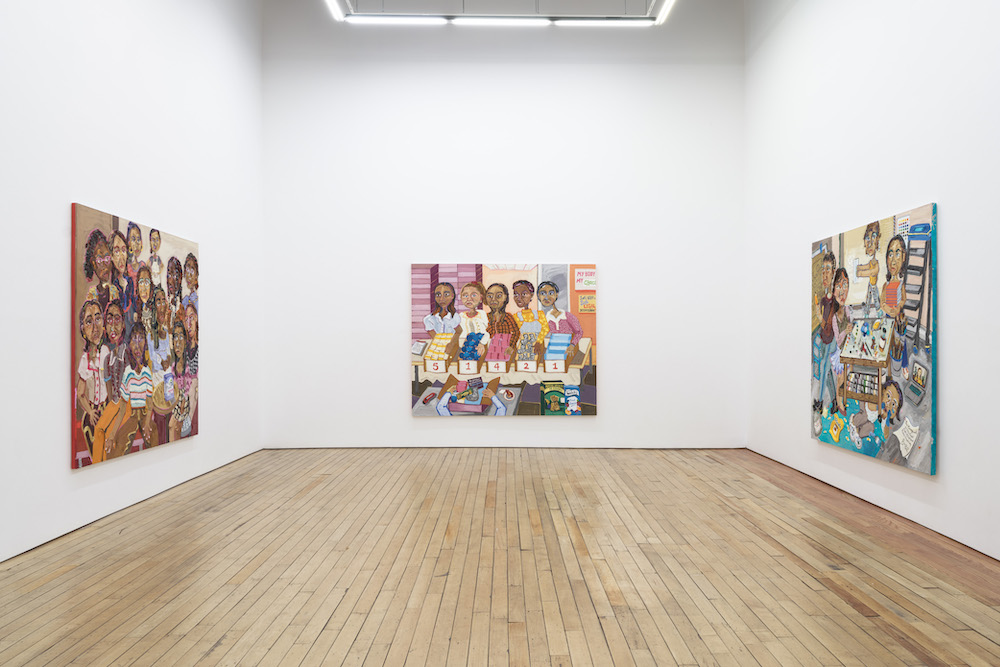
Installation view of Susan Chen’s “Plan B” at Rachel Uffner Gallery.
New Paintings Honor Care and Community
From the bodies in the first gallery, you proceed into the second, where we meet Chen and her friends in a series of large-scale paintings. Two explore the aftermath of the decision to overturn Roe v. Wade. Plan B: A Discussion depicts a group of women gathered around a Plan B box. The women seem to look to each other for support, while also processing their own distress. Chen modeled the composition and flattened perspective after feminist painter Sylvia Sleigh’s A.I.R. Group Portrait (1978), which features colleagues and artists from the women-only cooperative gallery, A.I.R. The allusion highlights a key difference; Sleigh’s subjects had finally won abortion access in 1973; Chen’s subjects had it stripped from them.
On the far wall, in the second painting, Chen has depicted a group assembling abortion after-care kits. Slightly abstracted versions of lemon tea, stress balls, menstrual pads, fruit snacks, granola bars are distributed by unsmiling volunteers, each ready to pluck an item for placement in a kit. Everything is colorful—pink walls, checkered shirts—but the tone is business-like.
The painting is based on Chen’s own experience volunteering at Planned Parenthood, and Chen picked her subjects from hundreds of women who offered to sit for the painting. “People were so open and excited about the mission of the painting. It just happened organically for the first painting, and when I was making this painting, it was interesting to me that a lot of women—actually almost everybody—had experiences taking Plan B but they had never talked about it. We all had similar feelings. To this day, we still feel kind of guilty.”
Chen is interested in collectivity; even in her self-portrait, entitled The Paintings Are Not Going to Paint Themselves, she rejects the myth of the lone, divinely ordained genius. In the painting, she hides under her table of paints, crying and cowering in her Crocs (ft. Bob Ross Jibbitz). Assistants prepare her paints and canvases, the floor is littered with Ricola, a jug of solvent, and a consignment contract. This canvas, like the others, is thick with frosting-like impasto, the oil paint heaped on so thick that it feels like the painting might paint itself.
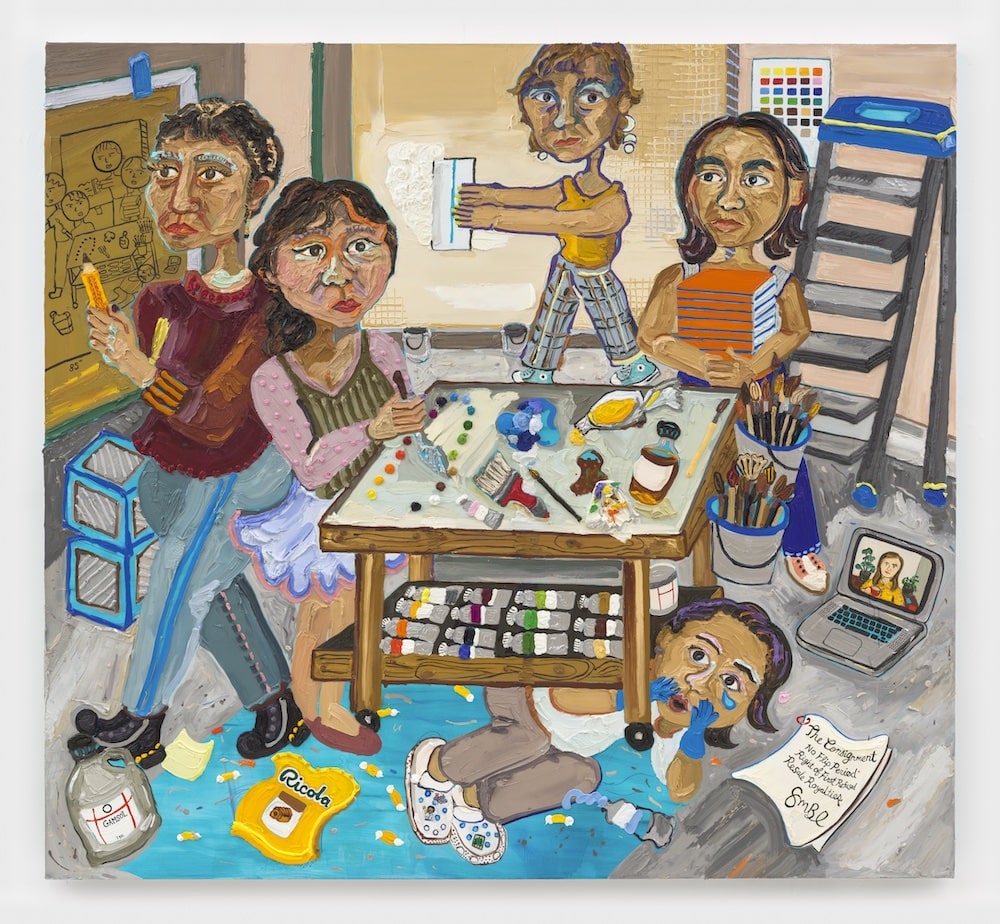
Susan Chen, “The Paintings Are Not Going to Paint Themselves,” 2023, oil on linen, 78 x 85 inches, courtesy of the artist and Rachel Uffner Gallery.
“‘Plan B’ was less about the product and more about how in life, Plan B usually becomes Plan A,” — Susan Chen
Between the Ricola, the Jibbitz, and the branded ceramics, Chen deliberately announces the exact conditions in which her works were produced. When I asked her about her decision to include so many logos, she explained, “If we look at Andy Warhol’s Brillo pads, you’re like ‘oh, this reflected the economy then, or people were moving into suburbia.’ Purell to me was definitely a marker of time. It was what was happening around the whole world. It feels reflective, like a self-portrait for anyone.” Chen pulls on a visual culture that we recognize, reasserting our proximity to what she depicts.
The paintings prioritize emotion, community, and real people, in a way that counters the disembodied ceramic products in the first gallery. The two sections offer different sides of the same problem; how control is exercised in one room and, in the other, the people whom such control affects. The community built around the ceramics is invisible, their bodies representing unspoken (but shared) experiences. The paintings visualize these commonalities and conversations, thinking about behind-the-scenes support systems.
“Plan B” slots into a long tradition of feminist art, thinking about what choices are available to us and how our lives are determined. That is what it all boils down to. Or, as Chen put it, “‘Plan B’ was less about the product and more about how in life, Plan B usually becomes Plan A. You think life is going to be like this, but then it turns into something completely different.”
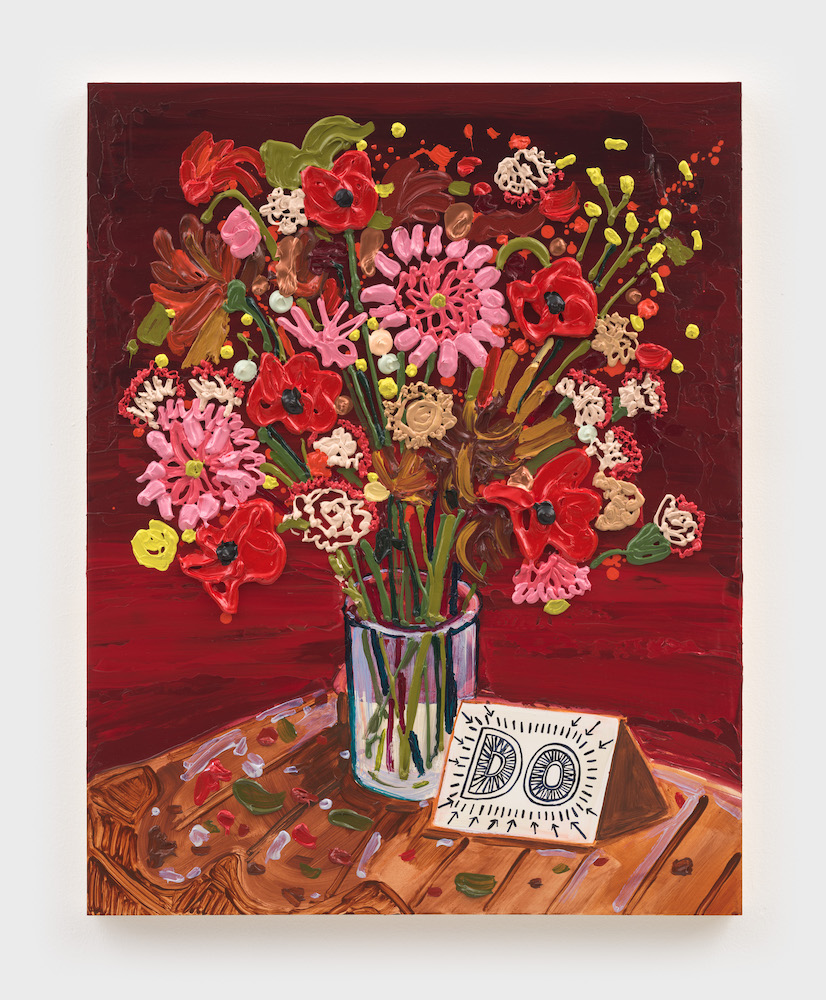
Susan Chen, “Just Do VII,” 2024, acrylic on panel, 28 x 22 inches, courtesy of the artist and Rachel Uffner Gallery.







